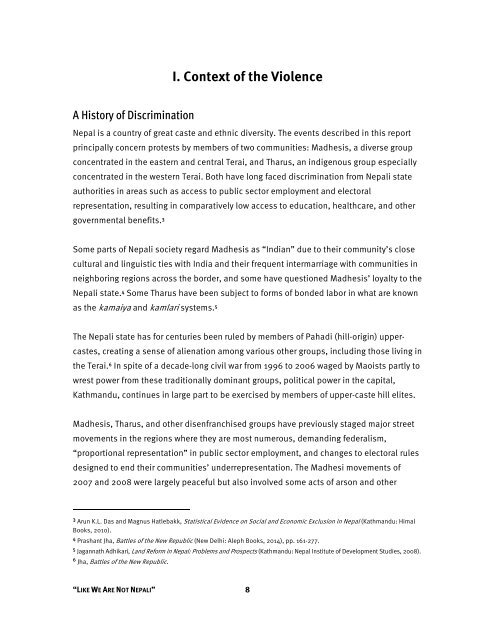“Like We Are Not Nepali”
7KiiNLWaT
7KiiNLWaT
Create successful ePaper yourself
Turn your PDF publications into a flip-book with our unique Google optimized e-Paper software.
I. Context of the Violence<br />
A History of Discrimination<br />
Nepal is a country of great caste and ethnic diversity. The events described in this report<br />
principally concern protests by members of two communities: Madhesis, a diverse group<br />
concentrated in the eastern and central Terai, and Tharus, an indigenous group especially<br />
concentrated in the western Terai. Both have long faced discrimination from Nepali state<br />
authorities in areas such as access to public sector employment and electoral<br />
representation, resulting in comparatively low access to education, healthcare, and other<br />
governmental benefits. 3<br />
Some parts of Nepali society regard Madhesis as “Indian” due to their community’s close<br />
cultural and linguistic ties with India and their frequent intermarriage with communities in<br />
neighboring regions across the border, and some have questioned Madhesis’ loyalty to the<br />
Nepali state. 4 Some Tharus have been subject to forms of bonded labor in what are known<br />
as the kamaiya and kamlari systems. 5<br />
The Nepali state has for centuries been ruled by members of Pahadi (hill-origin) uppercastes,<br />
creating a sense of alienation among various other groups, including those living in<br />
the Terai. 6 In spite of a decade-long civil war from 1996 to 2006 waged by Maoists partly to<br />
wrest power from these traditionally dominant groups, political power in the capital,<br />
Kathmandu, continues in large part to be exercised by members of upper-caste hill elites.<br />
Madhesis, Tharus, and other disenfranchised groups have previously staged major street<br />
movements in the regions where they are most numerous, demanding federalism,<br />
“proportional representation” in public sector employment, and changes to electoral rules<br />
designed to end their communities’ underrepresentation. The Madhesi movements of<br />
2007 and 2008 were largely peaceful but also involved some acts of arson and other<br />
3 Arun K.L. Das and Magnus Hatlebakk, Statistical Evidence on Social and Economic Exclusion in Nepal (Kathmandu: Himal<br />
Books, 2010).<br />
4 Prashant Jha, Battles of the New Republic (New Delhi: Aleph Books, 2014), pp. 161-277.<br />
5 Jagannath Adhikari, Land Reform in Nepal: Problems and Prospects (Kathmandu: Nepal Institute of Development Studies, 2008).<br />
6 Jha, Battles of the New Republic.<br />
“LIKE WE ARE NOT NEPALI” 8


